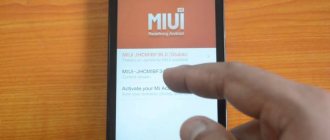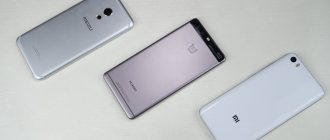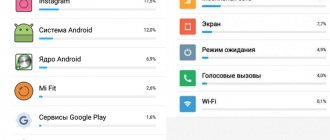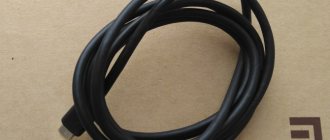Updated 07/02/2020. Xiaomi is one of those manufacturers that have proven their professionalism, but, as is usually the case, for everything good there are hundreds of products from unscrupulous “pirates”. In this article, we will analyze all the methods for checking the authenticity of smartphones and other Xiaomi devices.
Xiaomi authentication by imei
There is now only one official verification method - through the manufacturer’s website using the IMEI number, serial number or security code.
First you need to find out your IMEI and serial number , there are three ways:
- There is a sticker with numbers on the box of the device (sometimes it can also be found on the back cover of the smartphone or on the battery);
- Enter *#06# in the phone's dialing menu to display the IMEI;
On phones with dual SIM cards, 2 imei numbers will be displayed, this is normal.
- Go to “Settings” -> “About phone” -> “General information”, where you can find the serial number (SN).
To check the authenticity of a Xiaomi smartphone or tablet, you need to:
- Go to the website https://www.mi.com/global/verify/#/ru/tab/imei;
- The “Device Verification” tab (“Verify your phone purchase” in the English version) should be open;
- Enter the IMEI number or device serial number (S/N) in the special field
- Enter the verification code (captcha);
- Click “Verify” (“Verify” in the English version);
- You will see the result of the check, a green circle means you have an original, a red circle means it’s a fake.
If all the inscriptions are displayed in English, you can turn on Russian in the upper right corner of the site.
There are 3 check results:
- You have an original device;
- The authenticity of the device has not been confirmed, there is a high risk of counterfeiting;
- Invalid data entered. Typically, the error “Your IMEI or S/N doesn't exist, please verify and enter again” appears. Double-check your data to make sure there are no spaces at the beginning or end of the number.
This method is suitable for each model range of Xiaomi smartphones and tablets: Mi, Redmi, Mi pad, Android One (A series).
Additionally, you can try entering the number in the search engine. If in the search results you see sites with the numbers of your device in the public domain, then most likely you have a fake or a device assembled from spare parts of used gadgets (this can be found on Aliexpress).
First way
First of all, you should check the fifteen-character IMEI code, as well as the serial number on the manufacturer's website. To find out such details there are several options available:
- Dial #6# in the call menu;
- View the code in the smartphone settings by going to the “About device” section;
- Look at the back of the device or battery;
- Take the information on the packaging.
By going to the manufacturer’s website, you should enter the received numbers in the designated sections and pass the security check by entering a captcha. Next, to get the result, you need to click “Verify”. After this, the site will give you information regarding the desired device and determine whether it is original. If the number you entered is not in the manufacturer's database, then you were given a fake.
But even the presence of the original number cannot guarantee that illegal manufacturers could not use this code for their own purposes. You also need to know the number of checks of your number. If it equals one, then there are no problems. However, if the value is small, for example 2-3, then this does not mean that you are purchasing a non-original Xiaomi product. Sometimes the store starts checking the devices for sale. Accordingly, if the number of requests is large, then they are trying to deceive you and sell you a fake product.
Checking for originality using a security code
There is another verification method on the official website:
- Follow the link https://www.mi.com/global/verify/#/ru/tab/secur;
- By clicking on the link, a second tab should open called “Xiaomi Product Authentication”;
- Take the box from your Xiaomi device and then look for a secure field on it that you can erase. You have also seen such fields on mobile recharge cards;
Recently, not every model (especially new ones) has a similar code on the box!
- Having erased the protective layer, we will find a 20-digit code, the numbers from which we enter into the first field;
- Enter the captcha in the second field and click the “Verify” button (“Verify” in the English version).
This way you will be able to understand whether your device has passed the originality test. A positive result will display the number of checks for this code, which should be no more than one.
Checking through the AnTuTu Officer application
AnTuTu Officer is a special application for authentication. It can be downloaded from Google Play Market. After installing the program, you will need to open the y.antutu.com website on another device. In the phone application, you need to click “Start” and scan the QR code from the site. After scanning, the result will come out (green - everything is good, red - fake).
Note! If an uncertain result appears, do not worry - this often happens with the Global version. You can pass other tests.
Checking by external signs
Checking by external signs does not give 100% certainty, however, these factors may force a more thorough investigation.
Technical support
Checking by external signs does not provide 100% certainty, however, these factors may give rise to a more thorough investigation.
It is worth paying attention to external features:
- Poor-quality materials of accessories - the power adapter, headphones, cable can be detected by touch. As a rule, the plastic feels unpleasant or the assembly itself is flimsy and does not inspire confidence;
- Models that must have a metal or glass body are made of plastic ;
- The display or case very quickly becomes covered with scratches or even cracks;
- discharges very quickly from the first days - some sellers on Aliexpress sell phones with fake batteries;
- The screen is grainy , it causes eye fatigue and unnatural color rendition is visible;
- Large black frames around the screen are striking ;
- The layout of the buttons and ports differs from images from official sources.
In addition to external signs, it is worth carefully studying the operation of the smartphone and its software:
- Mi and Redmi models should have Miui shell . Try updating the firmware through the settings item; as a rule, fakes give an error;
- An unknown has been entered (a sign of using a phone or assembly from different donors);
- slowdown , lags;
- Unstable operation of modules (camera, autofocus, microphone, speaker, loss of cellular communication);
- Phone with clean firmware gets very hot
The last two points can mean either a fake or an ordinary defect.
Other options
There are also much simpler methods that may not be completely reliable, but are desirable for determining the originality of a product.
These are fairly simple manual checks:
- The elements of the gadget must fit tightly to each other with no backlash or similar defects in the body. If you can find parts of poor quality, this may confirm that it is not original;
- The smartphone should have a pleasant tactile sensation, since all Xiaomi products use high-quality components, while only replicas have raw plastic;
- It's worth checking out the software. Almost all Xiaomi smartphones (with one exception) run on Android with the proprietary MIUI shell;
- Technical parameters must agree with the official information of the gadget. If they convince you that this is a difference in assemblies, you need to refuse the purchase;
- It is not recommended to purchase at reduced prices in little-known stores.
We are convinced that with all the above recommendations, you will definitely be able to easily check your device for originality in order to avoid possible counterfeits in the services.
Checking with programs
Previously, a proprietary application “Verification tool” was used for verification, which no longer works. In addition to it, it was possible to use the “Antutu Officer” program from a third-party developer, but it also ceased to exist.
At the moment there are two ways:
- Conduct a performance test using the AIDA64, CPU-Z application (or any other application that will show the technical characteristics of the device).
QR Code
AIDA64
Developer: FinalWire Ltd
Price: Free
We go into the application, open the properties of your smartphone and compare the characteristics (display resolution, processor, frequency, battery capacity, etc.) with those declared by the manufacturer (the parameters can be found on the official website or other resources).
- Conduct a performance test using any benchmark (for example, geekbench 5).
QR Code
Geekbench 5
Developer: Primate Labs Inc.
Price: Free
We start testing, get the power expressed in points, and compare it with the results of the same model (data can be found on the Internet).
Finding out IMEI through the Xiaomi engineering menu
Xiaomi smartphones have a built-in engineering section; it is necessary for testing modules, chips and calibrating sensors. It is mainly used in repair shops, but you can easily get access to it.
To do this, open the settings, find the item “About phone” .
Then click on the line
“All parameters” . Click on the item “Kernel version” , after which the engineering software will automatically launch. In it we are interested in the item “Check version info” .
As you can see in the screenshot, both IMEIs are displayed along with the barcode, which is convenient for scanning by service equipment. Return to content
How to avoid counterfeits
To avoid counterfeit equipment, the investigator follows the following rules:
- Do not buy where the price is lowest (with the exception of well-known store brands);
- Purchase goods only from well-known stores;
- If possible, check the device before purchasing;
When purchasing from Aliexpress:
- Read reviews carefully;
- Choose a seller with a large number of purchases and a rich assortment;
- Do not make transactions with new sellers (these may simply disappear after a while).
Check at the point of purchase
We must remember how the global version of Xiaomi differs from the Chinese one. The product must be checked on site. The most common way to check is appearance. When purchasing a global version, you can see a Global Version sticker on the box, and the back panel of the smartphone is equipped with the inscription “Made in China” / “Made in India”, an image of a crossed out ballot box, and the letters “CE”. The charger plug corresponds to the type of socket in the country. The smartphone body itself has no defects. The OS must also match the version.
When buying a smartphone, you should always study it carefully. If the device was purchased through an online store and it is not authenticated, you should ask the seller for a refund and send the phone back. The same applies to retail stores.
Checking your Xiaomi phone for originality using visual inspection software
All Xiaomi phones come with the proprietary MIUI interface, they are inextricably linked with each other.
Therefore, even before purchasing a phone, you can make sure that MIUI is installed on the phone.
This can be easily done if you are already familiar with this shell and know what it looks like during normal operations with the device.
You can also find out by going to the device settings.
Step 1 – go to your phone’s general settings
You can do this by calling up the quick menu curtain and clicking on the gear sign, which is located in the upper right corner.
Step 2 – Find the “About Phone” menu item
Find the “About phone” menu item and enter it.
Next you will see a list of device firmware parameters, including the line “MIUI Version”. Opposite it there should be an inscription: “MIUI Global 10.0 | stable 10.0.1.0(OAAMIFH)". The inscription does not have to be like this (by numbers), but the general appearance should be the same. These numbers indicate the shell version and generation of MIUI that is installed on the device. Instead of the number 10 there can be a number 9, 8, 7 and below. If the general appearance of the inscription is like this, then MIUI is installed on the phone and the likelihood that it is an official phone increases significantly. But it doesn’t give complete confidence.
This is a good way to check the phone for originality if you don't have much time, or if you are looking at it in a store or buying it second-hand.
Return to content
How to check a phone for originality - all the differences
The question of buying a non-original device is tempting due to its affordable price. However, when agreeing to such a deal, you need to understand that there may be a pig in a poke under the lid.
It’s all the more disappointing when a purchase for a normal market price turns out not to be factory-made. This is already fraud on the part of the seller. Here you need to be very careful and when purchasing, pay attention to such details as:
- appearance,
- build quality;
- screen uniformity;
- features of the software;
- complete set;
- final cost.
To its credit, pirated copies are becoming more and more convincing. Sometimes the differences are so insignificant that you may not realize that the device is not original for years.
Most often, well-known and expensive models, such as brands such as Apple and Samsung, are counterfeited. Although recently Chinese quality products from companies such as Xiaomi, Meizu, Vivo, Nokia and others have also been in great demand.
Let's look at examples of offers from the Internet to mobile phones in a comparative table.
| Analogs | Original price | Price of fake |
| Apple iPhone 11 Pro Max 64GB | 100,000 rubles | 20,000 rubles |
| Apple iPhone 11 64GB | 60,000 rubles | 15,000 rubles |
| Apple iPhone X 64GB | 55,000 rubles | 13,000 rubles |
| Apple iPhone 8 64GB | 40,000 rubles | 10,000 rubles |
| Apple iPhone 7 32GB | 30,000 rubles | 6,500 rubles |
| Apple iPhone 6s 32GB | 25,000 rubles | 5,000 rubles |
| Samsung Galaxy S9+ 64GB | 40,000 rubles | 9,500 rubles |
| Xiaomi Mi Note 10 128GB | 40,000 rubles | 9,500 rubles |
| Huawei P30 128GB | 40,000 rubles | 9,500 rubles |
| Samsung Galaxy S10e 128GB | 46,000 rubles | 11,500 rubles |
The lower price level can be 2-3 thousand rubles. This is exactly how much cheap Chinese copies cost, which are then used to create imitations of prestigious companies with successful marketing and an unblemished reputation.
The list of the most counterfeit phones in the world includes products from Samsung (30.1% of counterfeits), Korean Xiaomi (37.3% of copies), and the American market leader, Apple (although due to the iOS security system, a duplicate can be quickly identified after switching on).











